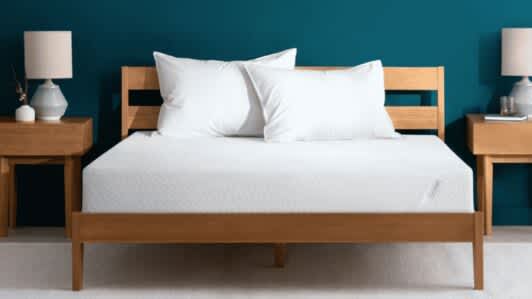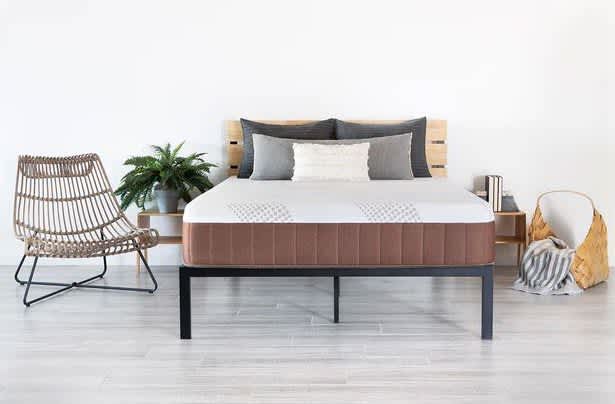On This Page
The Best Mattress Under $1,000
Our Top Picks
-
Best Overall Mattress
Tuft & Needle Original -
Most Comfortable Mattress
Dreamfoam Copper Hybrid -
Best Mattress for Side Sleepers
Silk & Snow Mattress
Best Overall Mattress

The Tuft & Needle Original offers excellent pressure relief, like many competing foam beds, but it stands apart from the competition with a slightly responsive feel that keeps your body from sinking too deep. This model was especially popular with back and stomach sleepers on our team.
Pros & Cons
Pros
- Offers a balance of contouring and bounce
- Graphite-infused open-cell polyfoam is designed to reduce heat retention
- Medium firm (6) feel accommodates a wide range of sleepers
Cons
- Side sleepers under 130 pounds may find the bed too firm
- Lacks strong edge support
Ratings
Our Take
Most Comfortable Mattress

The Dreamfoam Copper Hybrid combines the cushioning of foam with a sturdy coil base to produce a comfortable balance of contouring and support. With two firmness options to choose from, most of our testers found an option that catered to them.
Pros & Cons
Pros
- Available in two firmness levels
- Foam and coil design balances pressure relief and support
- Accessible price-point for a hybrid mattress
Cons
- Foam may produce temporary odor after unboxing
- Fee charged for returns
Ratings
Our Take
Best Mattress for Side Sleepers

The Silk & Snow Mattress is an all-foam mattress with a thick memory foam layer on top. This layer closely cradles your body, making the bed an excellent choice for side sleepers seeking strong cushioning for the hips and shoulders.
Pros & Cons
Pros
- Adaptive foam comfort layers cradle the body and relieve pressure
- Foam design limits noise and motion transfer to avoid disturbing co-sleepers
- Breathable, machine-washable cover
Cons
- Back and stomach sleepers over 230 pounds might experience uncomfortable sinkage
- Foam may trap some heat
Ratings
Our Take
Compare Our Top Picks
| Mattress | Mattress Type | Ideal For | Value | Sleep Trial |
| Tuft & Needle Original | Foam | Combination Sleepers | Great Value | 100 nights |
| Dreamfoam Copper Hybrid | Hybrid | Hot Sleepers | Great Value | 120 nights |
| Silk & Snow Mattress | Foam | Combination Sleepers | Great Value | 365 nights (30-night requirement) |
Mattress prices depend on so many variables, but all-foam or foam hybrid models are a great place to start when looking for quality beds under $1,000. I also highly recommend waiting for a major holiday, since many brands offer hefty discounts around events like Labor Day, Fourth of July, and Black Friday.
Video: Tips for Buying a Mattress on a Budget
Watch our video to learn more tips on buying a mattress with an affordable price tag.
How Much Should You Spend on a Mattress?
Research shows that many of us spend about a third of our lives sleeping. With that in mind, it’s worth investing in a quality mattress. The best mattress for you depends not only on your personal sleeping needs, but also on your budget.
Mattresses range from around $500 to over $2,000. While price varies widely depending on the quality of construction and materials, we’ve found that the most expensive mattress is not necessarily the best. We’ll discuss several factors that influence the price of mattresses.
What Affects the Price of a Mattress?
| Size | Larger sizes typically cost more, so one way to save money is to opt for the smallest size possible without sacrificing comfort. For example, choosing a queen size instead of a king can save money on a mattress for a couple. |
| Construction | Traditional innerspring beds and all-foam mattresses with just two or three layers tend to cost less. More complex designs and thicker layers drive up the price. That said, thin support systems may be less durable, which means you may need to invest in a new mattress sooner than you would with a more durable bed. |
| Where It’s Bought | Many brands offer affordably priced beds that also include free shipping and long sleep trials. Brick-and-mortar stores have higher overhead, and therefore less competitive pricing. |
| Special Features | Mattresses with special features like proprietary cooling technology, adjustable firmness, or other unique design elements often cost more. Some of these features, such as advanced cooling covers, may be offered as optional upgrades. |
What to Look for in a Mattress Under $1,000
When shopping for a mattress under $1,000, it’s important to consider a few factors to ensure that you get the best quality and fit for your money.
Mattress Type
Mattress type is determined by the materials used in a bed’s construction. The types of mattresses most commonly available at lower price-points are innerspring, foam, latex, and hybrid.
Traditional innerspring mattresses — those with just a thin comfort layer over a coil support system — are typically less expensive than other mattress types but offer very little pressure relief. Foam mattresses vary in price according to the quality, thickness, and overall number of foam layers. Memory foam is generally pricier than polyfoam, but is more durable.
Latex mattresses, especially those made from natural latex, are responsive and durable but usually carry a higher price-point. Hybrid mattresses have a more complex construction, with foam or latex comfort layers over pocketed coils, so they tend to be more expensive.
Material Quality
The quality of materials used in a mattress affects its durability and performance. While a higher price doesn’t always indicate a better mattress, examining the materials can give you a good sense of what to expect.
Latex and memory foam are generally more durable than low-density polyfoam. Pocketed coils provide strong support and offer more motion isolation than traditional innerspring models, in which all of the coils are connected to a single base. Natural and organic materials tend to cost more but are ideal for eco-friendly shoppers.
Shipping, Delivery, and Returns
When shopping online, make sure to factor shipping, delivery, and return fees into your budget. Many websites offer free shipping and delivery to the contiguous U.S. Some also offer free returns, while others charge a fee.
Many companies offer White Glove delivery, which involves professionals removing your old mattress and setting up your new one. Some brands include this service for free, but most companies charge a fee. If you have an old mattress or a difficult setup situation, the extra charge may be worthwhile.
Sleep Trial and Warranty
Many mattresses come with a sleep trial, which lets you try out the bed for a certain number of nights and return it for a full refund if you’re not satisfied. These trials usually range from 60 nights to an entire year, and are a great way to determine whether a mattress fits your needs.
Most mattress companies offer warranties against manufacturing defects which may last anywhere from a year to a lifetime. Sleep trials and warranties can help ensure peace of mind when purchasing a mattress.
How to Get the Best Deal on a Mattress
Once you choose a mattress in your price range, there are several buying strategies to help save even more money.
Consider Shopping Online
Where you buy a mattress can affect its price. Since online shops have less overhead than brick-and-mortar stores, they often offer more competitive prices. You’ll find many quality mattresses at lower prices from brands that only sell online.
Shopping at a brick-and-mortar store offers in-person guidance, as well as a chance to try out the mattress and take it home that day. However, many online mattresses include generous sleep trials and free, speedy shipping. Additionally, shopping online almost always offers a wider variety of choices than shopping in a store.
Take Advantage of Sales and Discounts
Mattress sales generally take place around national holidays like Fourth of July, Labor Day, and Memorial Day, and they often offer substantial discounts. Black Friday and Cyber Monday usually offer the best deals of the year for many brands. Coupons and special offers are also common year-round for online retailers, and some sellers offer price-match guarantees.
Companies sometimes offer bundling discounts, where they significantly reduce the mattress price if you purchase bedding or a frame at the same time as the mattress.
Account for Potential Added Costs
When budgeting for a mattress, make sure to anticipate associated costs. For example, if you’re buying a mattress that’s a different size from your previous bed, you’ll need to purchase a new frame and bedding to accommodate the new size.
Discover More Mattress Solutions
Even with a budget, your mattress options are virtually endless. We have a host of buying guides to help narrow your search.
More Mattress Options by Cost
How We Test
After many years of testing mattresses at a wide range of price-points, we’ve observed that a higher price does not always guarantee a better mattress. In order to ensure accurate performance ratings, we evaluated mattresses under $1,000 using the same criteria and testing methodology as we do for more expensive models.
Since every sleeper has different needs, our team is made up of testers that reflect a variety of sleeping positions, preferences, and body types. This allows us to provide inclusive data that can help you choose the best mattress for your unique needs.
Frequently Asked Questions
Mattresses vary widely in price, ranging from $500 to well over $2,000. A number of factors can affect price, including the size of the mattress, quality of materials, construction, and special features such as cooling technology.
The best mattress under $1,000 is one that meets your personal needs and is constructed from quality materials. Some extremely economical mattresses with flimsy comfort layers or thin support systems may not provide sufficient support and are likely to degrade quickly. However, it’s not hard to find a mattress with quality materials and construction for under $1,000.
While you can absolutely find a good mattress for under $1,000, you should consider your own needs and budget when deciding how much to spend. For example, a hot sleeper with budget flexibility may find it worthwhile to invest extra money in a bed with specialized temperature control features. Shoppers with a smaller budget may find that moisture-wicking sheets on a less expensive mattress serves them just as well.
To find a good deal on a mattress, take advantage of sales and discounts, online pricing, and bundling discounts. Sales are available year-round online but really ramp up around national holidays, Black Friday, and Cyber Monday. For those shopping online, many mattress-in-a-box companies sell directly to the consumer to avoid overhead and offer competitive prices. Also, you can often get a discount by bundling your mattress purchase with accessories like bedding or frames.
